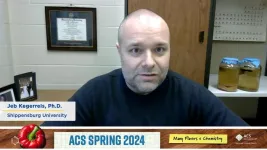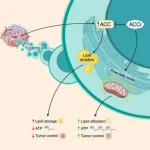The researchers will present their results today at the spring meeting of the American Chemical Society (ACS). ACS Spring 2024 is a hybrid meeting being held virtually and in person March 17-21; it features nearly 12,000 presentations on a range of science topics.
Kombucha brewing typically begins with a glass jar filled with tea, water, sucrose and a fermentation starter called a SCOBY — short for a symbiotic culture of bacteria and yeast. The yeast breaks down the sucrose, producing ethanol; simple sugars, glucose and fructose; and carbon dioxide. The bacteria then convert most of the ethanol and the remaining simple sugars into acetic, gluconic and lactic acids, which contribute to the flavor profile of the brew. But SCOBYs are alive and can be unpredictable. So, when the bacteria aren’t getting rid of the ethanol or developing the right acids for the flavor profile, the kombucha brewer may need a chemist to help them save future batches from the same fate.
“Brewers typically see making kombucha as an art more than a science,” says Jeb Kegerreis, a physical chemist and one of the team’s principal investigators. “So, when we are doing a consultation, we also walk the brewer through the biochemistry of what’s happening during fermentation.”
Kegerreis works with fellow analytical chemist and principal investigator John Richardson, who formed a consulting company within the university called Cultured Analysis to help kombucha producers and to discover new ways to optimize the brewing process. Together with undergraduate chemistry students, they’ve gained interesting insights into using alternative containers and SCOBY food sources for reliably brewing non-alcoholic and better-tasting kombucha.
Investigating the use of silicone bags as an alternative to glass jars for brewing kombucha came about when a fellow brewer shared with Richardson that the silicone sous vide bags they were using fermented the tea faster and created more acid compared to glass jars. The brewer understood the quick production of acids likely meant the bacteria were getting rid of ethanol faster, but they wanted the scientists’ help to figure out why.
The team found that a silicone bag’s porosity, compared to a nonporous jar, exposes the SCOBY to more oxygen, which speeds up the brewing process — including ethanol breakdown and acid production — and cuts production time from about two weeks to one week. But they were surprised to see inconsistent levels of dissolved oxygen in the silicone bags compared to the glass jars. “Next semester, we will investigate what else contributes to the silicone bag being a better brewing vessel,” says Emily Swartz, one of the team’s chemistry students.
According to Richardson's kombucha-tasting expertise, tea brewed in a silicone bag is just as delicious as tea brewed in a glass jar.
Speaking of taste, the researchers noticed that they were getting more gluconic acid with silicone bag brewing compared to jars. “We think this acid will become more popular with brewers,” says Kegerreis. “Gluconic acid provides acidity without the sour vinegar taste you get from acetic acid, and that may appeal to more tastebuds.”
Because gluconic acid is a product of bacteria fermenting glucose, the researchers investigated how starting with glucose or fructose instead of sucrose changes the kombucha fermentation process and taste. “During the fermentation process, yeast in the SCOBY breaks sucrose into glucose and fructose,” says chemistry undergraduate student Abbi Czarnecki. “By using just glucose or just fructose, we looked at how removing that first step affects the whole brewing process.”
The team found that using glucose as the SCOBY food source created a kombucha with more gluconic acid and minimal ethanol. With fructose, the researchers measured more acetic acid and more ethanol. “If minimizing ethanol production is the measure of our success,” says Ian Loscher, a chemistry undergraduate and one of the team’s poster presenters, “fructose failed in that department. Out of all three sugars, it produced the most ethanol.”
Richardson says the fructose brews tasted sweeter. “I prefer a less sweet kombucha, but it’s not necessarily bad,” he admits. What’s important to the team is sharing what they have discovered about different sugars and fermentation vessels because that information can help brewers create a kombucha that hits all the flavor notes and characteristics they want to aim for.
“Brewing kombucha can still be a very creative process,” says Richardson. “But when something goes wrong during fermentation, science can help make it right.”
The research was funded by Shippensburg University’s David A. and Anne B. Atkinson Undergraduate Research Endowment for the College of Arts and Sciences and by Shippensburg University Student Research — Undergraduate Research Grant Program.
Visit the ACS Spring 2024 program to learn more about these presentations, “Comprehensive comparison of the dynamics of kombucha fermentation in a silicone bag and a glass jar” and “Investigating the impact of sugar source variation on kombucha fermentation,” and other scientific presentations.
###
The American Chemical Society (ACS) is a nonprofit organization chartered by the U.S. Congress. ACS’ mission is to advance the broader chemistry enterprise and its practitioners for the benefit of Earth and all its people. The Society is a global leader in promoting excellence in science education and providing access to chemistry-related information and research through its multiple research solutions, peer-reviewed journals, scientific conferences, eBooks and weekly news periodical Chemical & Engineering News. ACS journals are among the most cited, most trusted and most read within the scientific literature; however, ACS itself does not conduct chemical research. As a leader in scientific information solutions, its CAS division partners with global innovators to accelerate breakthroughs by curating, connecting and analyzing the world’s scientific knowledge. ACS’ main offices are in Washington, D.C., and Columbus, Ohio.
To automatically receive news releases from the American Chemical Society, contact newsroom@acs.org.
Note to journalists: Please report that this research was presented at a meeting of the American Chemical Society. ACS does not conduct research, but publishes and publicizes peer-reviewed scientific studies.
Follow us: X, formerly Twitter | Facebook | LinkedIn | Instagram
Title
Comprehensive comparison of the dynamics of kombucha fermentation in a silicone bag and a glass jar
Abstract
Kombucha is a fermented tea beverage popular all around the world and known for its distinctly sour taste. The brewing of kombucha relies on a symbiotic culture of bacteria and yeast (SCOBY). One of the most important processes that occurs during a kombucha fermentation is the production of acetic acid. The yeast in the SCOBY convert a food source to ethanol, and the bacteria (when exposed to oxygen) convert ethanol to acetic acid. For non-alcoholic kombucha to be sold commercially, the alcohol by volume (ABV) must be less than 0.5%, so understanding ways to maximize bacterial activity becomes paramount. In our study, two different types of brewing vessels were analyzed to determine which produces more desirable ABV values. One vessel was an air-permeable silicone bag, and the other vessel was a one gallon mason jar. An equivalent batch of kombucha was brewed in each vessel, and pH, ABV, titratable acidity, dissolved oxygen concentration, and a benchtop Nuclear Magnetic Resonance (NMR) spectrometer was used to monitor sugar concentration. The sugar concentrations were validated by comparing the NMR results to those obtained using an enzymatic sugar testing kit. The air permeability of the bag increases dissolved oxygen levels, increasing the activity of the bacteria relative to the jar and lowering the ABV.
Title
Investigating the impact of sugar source variation on kombucha fermentation
Abstract
Kombucha is a fermented tea beverage that has become increasingly popular in recent times due to its health benefits related to its probiotic properties. The main components of a kombucha brew are tea, a SCOBY (Symbiotic Culture of Yeast and Bacteria), and a sugar food source. Because of the many fermentation products that create the unique flavor profile of each kombucha brew, information about the optimization of the brewing process has become important to members of the kombucha industry. Using glucose, sucrose, and fructose as different starting sugar food sources was found to produce different metrics in the completed brews that may be more favorable to kombucha brewers. Time dependent data was acquired using potentiometric titrations, gas chromatography, NMR, HPLC, and other techniques.
END







